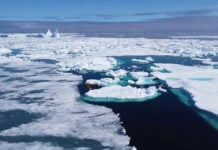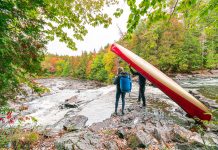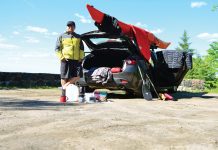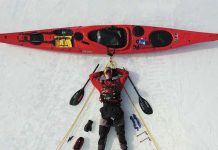In November 2022, an unusual call found its way into Paddling Magazine’s Facebook newsfeed: “Teammates wanted for Northwest Passage kayak expedition: Must be able to sea kayak in very cold, turbulent waters for 12 to 20 hours at a stretch… Expedition will potentially take 4+ months… While venting is accommodated, whining won’t be tolerated. No pooping inside the tent, regardless of the weather.”
This ad for expedition partners was posted by endurance paddler West Hansen, and it’s an unlikely origin story for 2023’s most significant expedition. From this inauspicious beginning, the Arctic Cowboys were formed, setting the stage for a historic journey. On October 8, 2023, the foursome completed a world-first—a single-season, human-powered traverse of the Northwest Passage. This 1,600-mile route through Canada’s Arctic Archipelago, from Baffin Bay to the Beaufort Sea, was first recorded by Norwegian explorer Roald Amundsen between 1903 and 1906 and has beckoned adventurers since. Over the last four decades, roughly 20 expeditions of hardy paddlers and ocean rowers have attempted to complete the Passage, most over multiple seasons. A single-season traverse by kayak has only recently become possible due to a warming Arctic and greater sea ice melt.
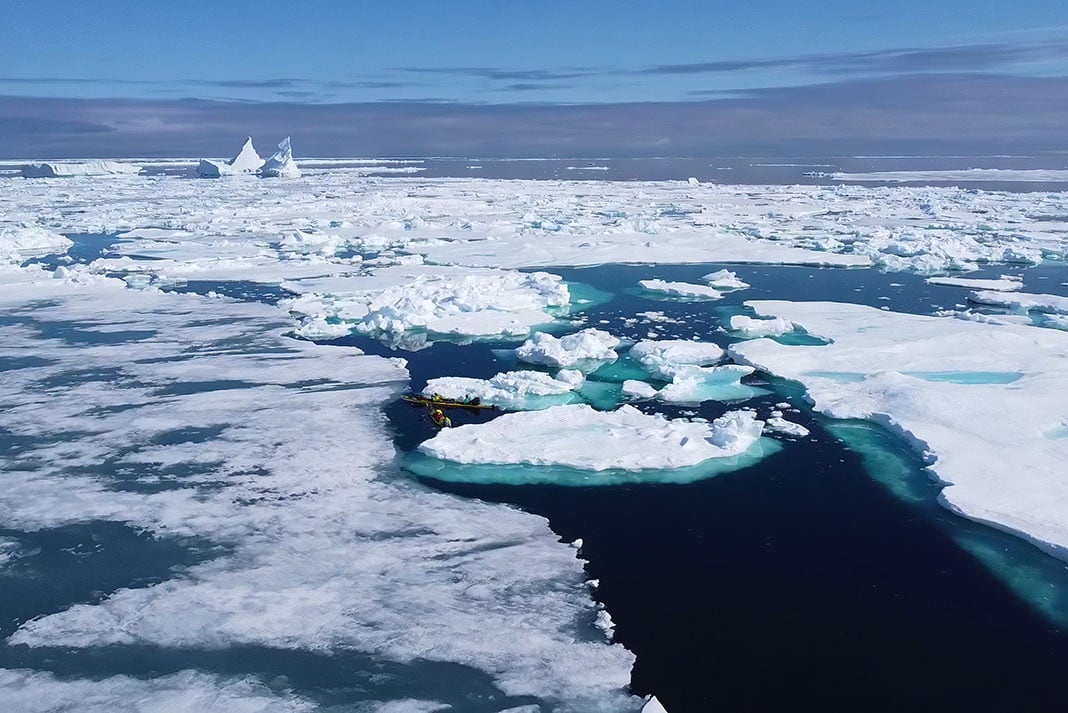
When Paddling Magazine spoke with expedition leader Hansen two months after returning home to the Texas sun, he said his toes were almost back to 100 percent. “A couple of them are still numb from frostnip, but my fingers have recovered. I think everything’s going to end up working just fine.”
Hansen is a veteran of endurance races and expeditions. For this journey, he recruited his longtime paddling partner Jeff Wueste, 63, with whom he previously paddled the 4,200-mile Amazon River and Russia’s 2,100-mile Volga River. American marathon kayaker Eileen Visser and Scottish endurance athlete Mark Agnew were recruited through Hansen’s Facebook post and joined the team.
Over 83 expedition days, the team faced difficult conditions, including 20-foot breaking waves, 60-mile-per-hour winds, whiteout blizzards and near-continuous freezing temperatures. As summer gave way to autumn, conditions kept the paddlers stormbound on land for almost as many days as they were on the water.
“During the second part of the expedition, we were hemmed in on land 40 percent of the time. The waves were high, it was getting colder, and the days were getting shorter,” Hansen says. “We were concerned about the weather and the wind constantly, but I was never concerned we weren’t going to finish. I just knew it was going to be a lot rougher the later in the season we got. Some people on the team were willing to push the button for a rescue, but I never got to that point.”
Nothing came easy in the Passage. It wasn’t just Hansen’s frostnipped fingers and toes suffering. Wueste soldiered on through a torn Achilles tendon, testicular hernia and shoulder injury. He’s had two surgeries since returning home.
The expedition was five years in the making and was Hansen and Wueste’s second attempt. In 2022, the duo was beset by bad weather, unexpected delays and the departure of their third teammate. They pulled the plug 260 miles and 17 days into the journey. However, the aborted mission proved invaluable for planning the second attempt.
“Information for the Northwest Passage is sparse. I read everything I could, but nothing substitutes for being up there,” says Hansen. “We thought we could average so many miles per day. That turned out to be completely wrong. You have to account for sitting absolutely still because the conditions were much larger than we expected.”
Not only would a successful trip require more food and fuel, but the team left a month earlier to give themselves more time. The Arctic Cowboys also made critical gear adjustments, including swapping their drytop and drypant combos for full drysuits, single kayaks for tandems, and Crocs for Muck Boots.
Below, Hansen shares his insights on the gear and strategies the Arctic Cowboys used on the Northwest Passage.
What’s in West Hansen’s Northwest Passage sea kayaking kit

1 Kindle
I’m a bibliophile. I enjoy reading novels as well as historic accounts of classic expeditions. My mother gave me this Kindle Paperwhite, and while I’ve never been a fan of e-readers, this was necessary because of space. When we were socked in our tent for six days at a time, there was nothing to do but read.
2 Muck boots
The first year, we had Crocs. They’re great for walking around in camp when you’re on a kayak expedition in warm climates. They didn’t work in the Northwest Passage. Our feet were always wet. Muck Boots are insulated, dry, light, easy to carry and rugged enough to handle sharp rocks. We’re not sponsored by Muck Boots, but I recommend them to everyone.
3 Layers
When we were moving, we were able to stay warm. The problem was the transitions—changing from our warm camp gear into drysuits was probably the hardest part of the expedition. Under the drysuits were polypro underlayers. We paddled with pogies and caps most days. Other team members could wear socks under their booties, but I couldn’t because my shoes were too tight, and my feet suffered.
I can’t tell you exactly how cold it was, though. We communicated with our support crew twice a day, and I asked them never to tell us the temperature. The last three weeks never got above freezing. We would hit the bank, and everything was frozen on the decks of our kayaks.
4 Winchester SXP Defender
We saw one to six bears every day, often with cubs. We saw them on the shore, on ice floes we navigated between and in our camps. They were smart and generally stayed away from us, but sometimes we’d have to shoot an exploding flare towards them. They took the hint and would run off. The shotgun was louder than the flares, so I used the gun maybe three or four times. The last bear we saw woke us up by rubbing against our tent. It got past our movement alarms because the batteries were dying. I couldn’t hear anything because my earplugs were in. The team poked me awake and pulled my sleep mask off. They were all sitting up, and I could see the silhouette of a bear against the tent wall. I was awake then.
5 Bear-torn shirt
I had laid this shirt across a boulder to theoretically dry out, as we had 24 hours of sunlight at the time. Then, the polar bear mentioned visited. When the bear left, I found he’d torn up my shirt. I guess he didn’t like my odor after not bathing for two months.
6 The Explorers Club flag
These flags go back to 1918 and are awarded to exceptional expeditions. This flag is number 214. It’s been on seven previous expeditions, including to Alaska, Russia and Belize.
7 North Face Bastion 4
We had winds up to 60 miles per hour and snow drifts piled up against the tent. The tent never threatened to come down. We had a giant vestibule out front to cook in. It was tight, but it kept us warm. The team didn’t come together until we met at the airport on the way to the Arctic. So, when we were up there, it was the first time we had spent with Eileen and Mark. It took some adjustment to get used to new people on an expedition. What was important in expedition partners was their sense of humor and the ability to get along with others. On shore days, we did crossword puzzles as a group, played trivia games and sang songs. By the end, we knew so much about each other that we didn’t really talk much.
A lot of people think it takes an adrenaline junkie to do this type of thing and just the opposite is true. I’m very cautious.
8 Musk ox horn
The musk ox are incredible animals. They’re like prehistoric cattle. Very ominous looking. You need special permission to take a horn out of the country, and you can see the little tag if you look closely.
9 Seaward Passat G3 XL
We switched from solo kayaks to tandems in 2023. I wanted to go faster—we knew the window of opportunity was limited, and you’re only as fast as your slowest team member. Tandem kayaks can also handle rougher conditions than a solo, on average. And, we could pile a lot more stuff on top of the tandem kayaks’ decks, and the volumes inside were greater.
At the end of the journey, we had completed the Passage but were still 150 miles from the community of Tuktoyaktuk. Winter was coming down on us like gangbusters. A Twin Otter plane picked us up, but the kayaks were too long to load. So, we cut four feet off the sterns with a hacksaw. A couple of guys on the team wanted to burn the kayaks, so I don’t think any of us were too heartbroken. They’re being repaired now.
10 Carry handles
These are gate handles from Home Depot. They’re large so you can fit a gloved hand underneath. When your hands are numb, you can’t manage little handles. It was a $5 fix. The kayaks are 90 pounds unloaded, but loaded and crusted in ice, they were closer to 400 pounds. It was a chore to drag them past the tide line.
11 West Hansen
I am just a regular guy. I’m a social worker. I’m not the fastest racer out there, and I certainly don’t have any money—I’m in debt from this expedition. A lot of people think it takes an adrenaline junkie to do this type of thing and just the opposite is true. I’m very cautious. A couple of our team members were gung ho, and they wanted to go when I considered the conditions too dangerous. We ended up sitting still for much more than they wanted, and there was a lot of tension because of that. But caution has helped me succeed on all my expeditions. Even in 2022, when we pulled the plug because the margin of error was too great.
These expeditions are more possible than people think. Yes, sacrifices are made. I hated being away from my wife and daughter; that was rough. Mark’s wife was pregnant, and they have a one-year-old at home. Jeff is self-employed and did a lot of business by satellite phone from 3,000 miles away. We’re just regular folks. We don’t have any special physical abilities. Perseverance is the key. If you really want to do something like this, you find a way to get it done.
“Tracing one warm line through a land so wild and savage.” —Stan Rogers, Canadian folk singer | Feature photo: Courtesy The Arctic Cowboys



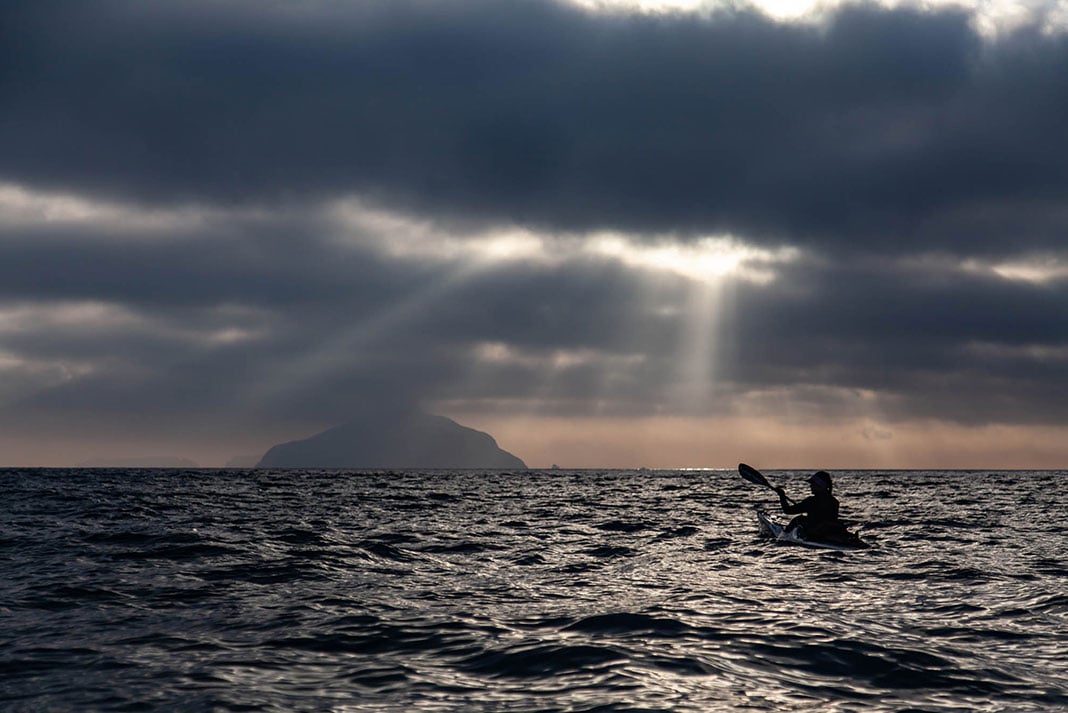

 This article was first published in the Spring 2024 issue of Paddling Magazine.
This article was first published in the Spring 2024 issue of Paddling Magazine. 